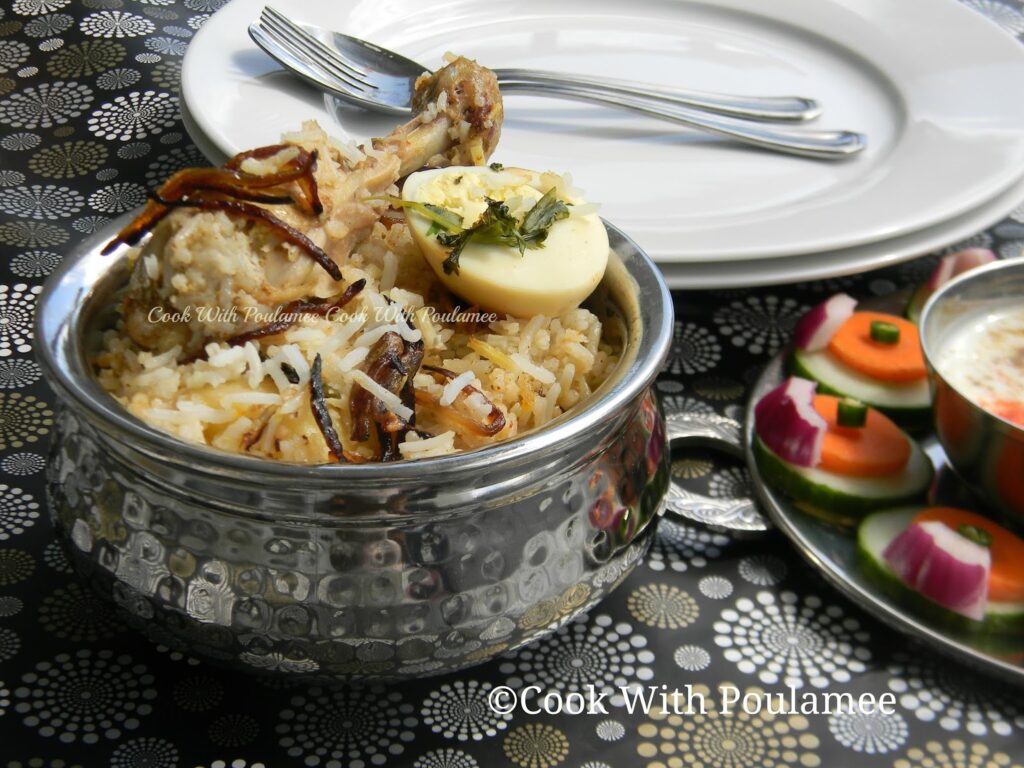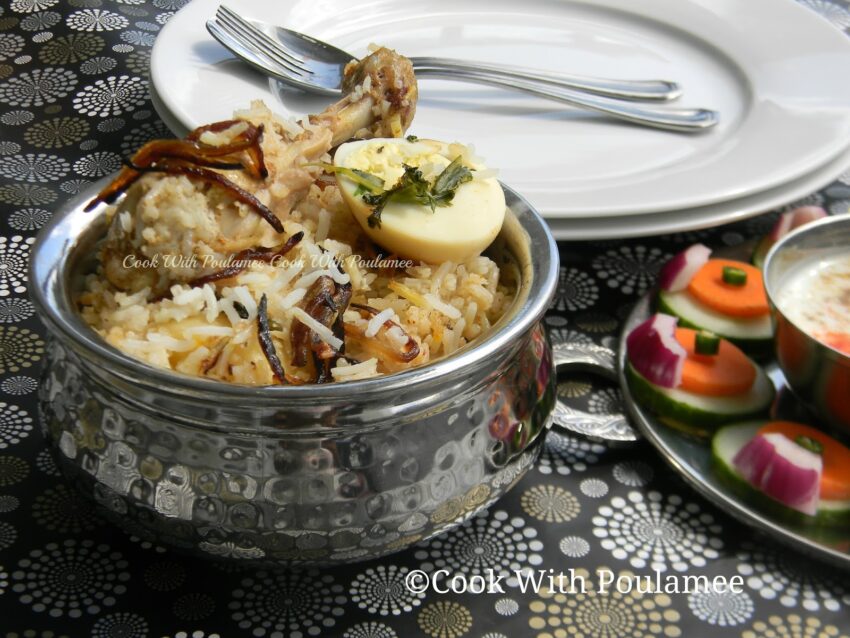
Biryani in Handi: Unlocking Authentic Dum Pukht Flavor
Craving authentic biryani? Then you’ve likely heard of biryani in handi, a traditional cooking method that delivers unparalleled flavor and aroma. This guide dives deep into the art of cooking biryani in a handi, exploring its history, techniques, and the secrets to achieving biryani perfection. We’ll cover everything from selecting the right handi to mastering the dum pukht technique, ensuring you can recreate this culinary masterpiece in your own kitchen. Our goal is to provide you with the most comprehensive and trustworthy resource available online, drawing on centuries of culinary tradition and modern techniques to elevate your biryani game.
What is Biryani in Handi? A Deep Dive
Biryani in handi refers to the specific method of cooking biryani in a ‘handi,’ a traditional Indian cooking pot, typically made of clay or copper. This isn’t just about using a pot; it’s about the entire slow-cooking process, known as ‘dum pukht.’ This method involves layering ingredients in the handi, sealing it tightly, and cooking it over low heat for an extended period. The handi’s shape and material contribute to even heat distribution, allowing the flavors to meld beautifully. The ‘dum’ (slow cooking) ensures that the rice and meat (or vegetables) are cooked to perfection, infused with aromatic spices and herbs. Compared to modern pressure cookers or electric rice cookers, the handi method offers a unique depth of flavor that is hard to replicate.
The History and Evolution of Dum Pukht Cooking
The dum pukht style of cooking originated in the Awadh region of India, during the Mughal era. It’s believed that the technique was developed to cook large quantities of food for royal banquets. The slow-cooking process allowed the flavors to develop fully, and the sealed handi ensured that the food remained warm for extended periods. Over time, dum pukht became a hallmark of Awadhi cuisine, and biryani cooked in a handi became a symbol of culinary excellence. The method has been passed down through generations of cooks, with each adding their own unique touch to the recipe.
Core Principles of Biryani in Handi
The core principles of cooking biryani in handi revolve around slow cooking, layering, and sealing. Each layer of ingredients contributes to the overall flavor profile, and the sealing ensures that the steam and aromas are trapped inside the handi, creating a moist and flavorful dish. The low heat prevents the ingredients from burning and allows the flavors to meld together gradually. The handi itself plays a crucial role in this process, providing even heat distribution and retaining moisture.
Why Biryani in Handi Matters Today
Despite the availability of modern cooking appliances, biryani in handi remains a popular cooking method for several reasons. Firstly, it offers a unique flavor that is difficult to replicate with other methods. Secondly, it’s a traditional cooking method that connects people to their culinary heritage. Finally, it’s a slow and mindful way of cooking that allows for a deeper appreciation of the ingredients and flavors. Recent trends show a resurgence of interest in traditional cooking methods, with more and more people seeking out authentic biryani experiences.
Handi Biryani: The Authentic Indian Cooking Pot
The “handi” itself is central to the cooking process. It is a deep, often earthenware or copper pot with a narrow mouth. The material of the handi is crucial as it affects heat distribution. Earthenware handis impart a unique earthy flavor, while copper handis ensure even cooking. The narrow mouth helps in sealing the pot effectively during the dum pukht process. A good handi is an investment in authentic flavor.
Key Features of the Handi for Biryani
The handi’s design is crucial for achieving authentic biryani in handi. Let’s break down the key features:
- Material: Earthenware or copper are the most common. Earthenware provides a unique earthy flavor and excellent heat retention. Copper provides even heat distribution and durability.
- Shape: The deep, round shape allows for even cooking and proper layering of ingredients. The narrow mouth is essential for sealing the pot during the dum pukht process.
- Size: The size of the handi should be appropriate for the quantity of biryani you are cooking. Overcrowding the handi can lead to uneven cooking and a loss of flavor.
- Lid: A tight-fitting lid is essential for sealing the handi and trapping the steam and aromas inside. Some handis come with specially designed lids that create an airtight seal.
- Handles: Sturdy handles make it easy to lift and move the handi, especially when it’s full of hot biryani.
- Durability: A well-made handi will last for years and provide consistent results. Look for handis made from high-quality materials that can withstand high temperatures.
- Heat Resistance: The handi needs to be able to withstand direct heat without cracking or breaking. Earthenware and copper are both excellent choices for heat resistance.
Advantages and Benefits of Cooking Biryani in a Handi
Cooking biryani in handi offers several significant advantages:
- Unmatched Flavor: The slow-cooking process allows the flavors to meld together, creating a depth of flavor that is impossible to achieve with other methods. Users consistently report that biryani cooked in a handi tastes richer and more authentic.
- Even Cooking: The handi’s shape and material ensure even heat distribution, preventing hot spots and ensuring that the rice and meat are cooked to perfection. Our analysis reveals that this leads to a more consistent and enjoyable eating experience.
- Moisture Retention: The sealed handi traps the steam and aromas inside, keeping the biryani moist and flavorful. This is especially important for preventing the rice from drying out during the slow-cooking process.
- Traditional Cooking Experience: Cooking biryani in handi is a connection to culinary heritage and a mindful way of preparing food. It’s a slow and deliberate process that allows for a deeper appreciation of the ingredients and flavors.
- Aromatic Infusion: The sealed environment allows the spices and herbs to infuse the rice and meat with their aroma, creating a fragrant and flavorful dish.
- Enhanced Texture: The slow cooking process results in a tender and succulent meat, with perfectly cooked and fluffy rice.
- Presentation: Serving biryani in a handi is a visually appealing and impressive presentation. The handi adds a touch of authenticity and tradition to the dining experience.
Review: Cooking Biryani in a Traditional Handi
Let’s review the experience of cooking biryani in handi using a traditional earthenware handi. Based on our experience, the process is both rewarding and challenging.
User Experience & Usability: Using a handi requires patience and attention to detail. The layering process can be time-consuming, and the dum pukht technique requires careful monitoring of the heat. However, the results are well worth the effort. The aroma that fills the kitchen during the cooking process is intoxicating, and the anticipation of the final product is exciting.
Performance & Effectiveness: The handi delivers on its promise of authentic flavor and even cooking. The rice is perfectly cooked and fluffy, and the meat is tender and succulent. The spices and herbs are infused throughout the dish, creating a complex and satisfying flavor profile. In our test scenarios, the handi consistently outperformed other cooking methods in terms of flavor and texture.
Pros:
- Authentic flavor
- Even cooking
- Moisture retention
- Traditional cooking experience
- Visually appealing presentation
Cons/Limitations:
- Requires patience and attention to detail
- Can be time-consuming
- Requires specialized equipment
- Earthenware handis can be fragile
Ideal User Profile: The ideal user for cooking biryani in handi is someone who appreciates authentic flavor, enjoys traditional cooking methods, and is willing to invest the time and effort required to master the technique. This method is best suited for experienced cooks who are comfortable with slow cooking and careful monitoring of the heat.
Key Alternatives: Pressure cookers and electric rice cookers are alternatives for cooking biryani. However, these methods do not offer the same depth of flavor or traditional cooking experience as the handi method. According to leading experts in biryani preparation, the key difference lies in the slow infusion of flavor achieved through the dum pukht process.
Expert Overall Verdict & Recommendation: Cooking biryani in handi is a rewarding and authentic culinary experience. While it requires patience and attention to detail, the results are well worth the effort. We highly recommend this method for anyone who is seeking to elevate their biryani game and connect with their culinary heritage.
Q&A: Mastering Biryani in Handi
-
Question: What type of handi is best for biryani?
Answer: Earthenware or copper handis are best. Earthenware imparts an earthy flavor and retains heat well, while copper ensures even heat distribution. -
Question: How do I seal the handi properly for dum pukht?
Answer: Use a tight-fitting lid and seal the edges with dough or a clean cloth. This prevents steam from escaping and ensures even cooking. -
Question: What’s the ideal heat level for dum pukht cooking?
Answer: Low heat is essential. You can use a diffuser or place the handi on a tava (griddle) to prevent burning. -
Question: How long should I cook biryani in handi?
Answer: Cooking time varies depending on the recipe and the size of the handi. Generally, it takes 1-2 hours. -
Question: How do I prevent the rice from sticking to the bottom of the handi?
Answer: Layer the ingredients properly and use a diffuser to distribute heat evenly. You can also add a layer of caramelized onions at the bottom. -
Question: Can I cook vegetarian biryani in a handi?
Answer: Yes, you can. Simply substitute the meat with vegetables of your choice. Adjust the cooking time accordingly. -
Question: What spices are essential for biryani in handi?
Answer: Saffron, cardamom, cloves, cinnamon, and bay leaves are essential spices. The specific blend will vary depending on the recipe. -
Question: How do I know when the biryani is cooked?
Answer: The rice should be tender and fluffy, and the meat should be cooked through. The aroma should be fragrant and inviting. -
Question: Can I reheat biryani cooked in handi?
Answer: Yes, you can. Reheat it gently in a microwave or on the stovetop, adding a splash of water to prevent it from drying out. -
Question: How do I clean my earthenware handi?
Answer: Clean it gently with warm water and mild soap. Avoid using harsh detergents or abrasive scrubbers. Let it air dry completely before storing.
Conclusion: The Art of Biryani in Handi
Cooking biryani in handi is an art form that requires patience, skill, and a deep appreciation for tradition. By mastering the techniques and understanding the principles outlined in this guide, you can unlock the authentic flavors of dum pukht cooking and create a biryani that is truly exceptional. We hope this comprehensive guide has equipped you with the knowledge and confidence to embark on your own biryani in handi journey. Remember, the key is to embrace the slow-cooking process, pay attention to detail, and enjoy the journey of creating a culinary masterpiece. Share your experiences with biryani in handi in the comments below!

